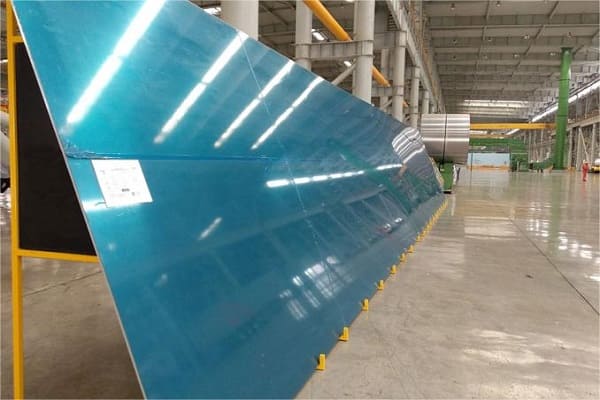Waa maxay 5086 darajada xaashida aluminium?
5086 aluminium saxan waa mid ka mid ah 5000 taxane (5taxanaha xxx) oo leh caabbinta daxalka sare. 5086 saxanka aluminiumku waa aluminium aan daxal lahayn oo leh maaddo sare oo birta magnesium ah. Waxaa si weyn loo isticmaalaa codsiyada u baahan iska caabin daxalka sare iyo weldability wanaagsan. xaaladaha xooga galmada iyo dhexdhexaadka ah.
 5086 aluminum-plates
5086 aluminum-plates5086 aluminum sheet chemical composition
| Alloy | Mg | Zn | Mn | ee | Cr | Fe | Individual | Total |
| 5086 | 3.5~4.5 | ≤0.25 | 0.20~0.7 | ≤0.15 | 0.05~0.25 | 0.000~0.500 | ≤0.05 | ≤0.15 |
Rust-proof 5086 xaashi aluminium
Aluminum-magnesium alloys and aluminum-manganese alloys are collectively called anti-rust aluminum, because the alloy components between them increase their anti-corrosion properties. Representatives of aluminum-manganese alloys are 3003 xaashi aluminium, 3004 xaashi aluminium, iyo 3105 xaashi aluminium. Aluminum-magnesium alloys are aluminum sheet 5005 5252 5251 5050 5052 5754 5083 5056 5086, iwm. according to the content of magnesium alloy.
Aluminium xaashida 5086 common thickness specifications
5086-H32 Aluminum Sheet 0.032″
5086-H32 Aluminum Sheet 0.040″
5086-H32 Aluminum Sheet 0.050″
5086-H32 Aluminum Sheet 0.063″
5086-H321 Aluminum Sheet 0.063″
5086-H116 Aluminum Sheet 0.080″
5086-H32 Aluminum Sheet 0.090″
5086-H116 Aluminum Sheet 0.100″
5086-H116 Aluminum Sheet 0.125″
5086-H32 Aluminum Sheet 0.125″
5086-H116 Aluminum Sheet 0.160″
5086-H116 Aluminum Sheet 0.190″
5086-H32 Aluminum Sheet 0.190″
5086-H116 Aluminum Plate 0.250″
5086-H116 Aluminum Plate 0.313″
5086-H116 Aluminum Plate 0.375″
5086-H32 Aluminum Plate 0.375″
5086-H116 Aluminum Plate 0.500″
5086-H32 Aluminum Plate 0.500″
5086-H116 Aluminum Plate 0.625″
5086-H32 Aluminum Plate 0.625″
5086-H116 Aluminum Plate 0.750″
5086-H116 Aluminum Plate 1.000″
5086-H116 Aluminum Plate 1.250″
5086-H116 Aluminum Plate 1.500″
5086-H116 Aluminum Plate 2.000″
5086 aluminum sheet physical properties
Cufnaanta: 2.66 g/cm³ (0.096 lb/in³)
Melting Point: 585°C to 655°C (1085°F to 1215°F)
Habdhaqanka kulaylka: 125 W/(m·K) at 25°C (77°F)
Coefficient of Thermal Expansion: 23.8 x 10^-6 /°C (13.2 x 10^-6 /°F) from 20°C to 100°C (68°F to 212°F)
Specific Heat Capacity: 0.89 J/(g·°C) at 25°C (77°F)
Electrical Conductivity: 31.2% IACS (International Annealed Copper Standard) at 20°C (68°F)
Qaabka Elasticity: 68.9 GPA (10,000 ksi)
What’s the difference between aluminum sheet 5086 iyo 5083?
Aluminum alloys 5086 iyo 5083 are both marine-grade alloys known for their excellent corrosion resistance in harsh environments, especially marine applications. Si kastaba ha ahaatee, there are some differences between the two, which mainly lie in their mechanical properties and composition:
alloy composition:
5086 Aluminium Aloy: The main alloying element of 5086 is magnesium. It also contains small amounts of manganese, chromium and other elements.
5083 Aluminium Aloy: Like 5086, 5083 is a magnesium alloy, but it also contains large amounts of chromium and trace amounts of manganese and iron.
Strength and mechanical properties:
5086: Generally slightly lower in strength than 5083, but still has good strength and excellent corrosion resistance. It is often selected for applications where weldability and corrosion resistance are critical.
5083: Compared with 5086, it has higher tensile strength and yield strength. It is known for its exceptional strength in harsh marine environments and is commonly used in structures that require high strength, such as the shipbuilding industry.
Weldability:
Both alloys are weldable, but 5086 is generally considered easier to weld than 5083. 5086 is known for its good solderability using standard soldering methods, halka 5083 may require more specialized soldering techniques to maintain its mechanical properties.
codsi:
5086: Commonly used in applications requiring moderate strength and high corrosion resistance, such as ship hulls, storage tanks and pressure vessels.
5083: Preferred in applications where higher strength and toughness are critical, such as the construction of naval vessels, cryogenic tanks and structural components.
